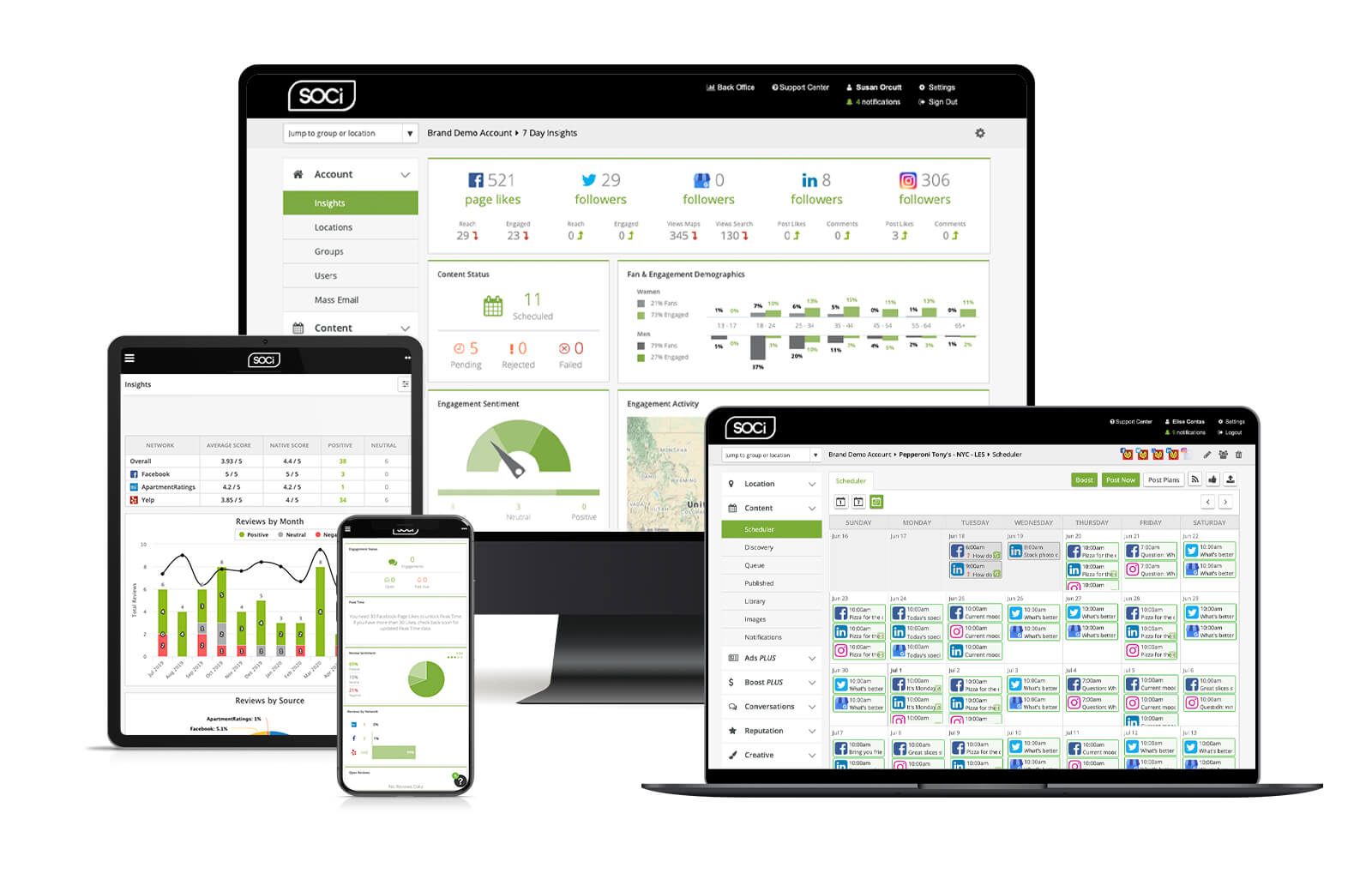4 Social Media Tactics Every Financial Professional/Institution Should Be Using
Which Social Media Insights Matter Most + How to Measure Them

Which Social Media Insights Matter Most + How to Measure Them
Today, there are an estimated 4.95 billion daily social media users worldwide; these users spend nearly two and a half hours daily on various platforms. With social media's prominent role in people’s lives, social media marketing is a must. That said, a ton of data comes out of social media marketing. So, what are the social media insights that matter most? In this blog, we’ll define what social media insights are and why they’re essential to your social media marketing and advertising efforts. We’ll also explain how to best use your social media insights to your advantage. More than eight out of 10 consumers have discovered a product on social media and directly purchased it on their smartphone. Don’t miss out on these opportunities by not understanding your social media marketing insights!What are Social Media Insights?
Social media insights are data metrics from individual social platforms and your social media marketing campaigns that you can analyze and leverage to influence your company’s business decisions.Social media insights come in two main ways:
- From individual social platforms’ data and analytics
- From your internal metrics and key performance indicators (KPIs).
Types of Social Media Insights
Below are the two main types of social media insights businesses should pay attention to. Note that both types influence each other, so there’s some overlap between them. Most importantly, you can use these insight types together to refine your organic (unpaid) and paid social media marketing campaigns and other internal strategies and efforts, such as lead generation, online reputation, and customer experience.1. Audience Insights
You don’t want to publish social media content and campaigns targeted to the wrong consumer group. Learning the makeup of your target audience early on will save you time, energy, and money. We recommend running low-cost paid social media ads at first because you have more control over your audience’s demographics with paid ads or boosting than your unpaid campaigns. Below are a few demographics you can input on most major social media platforms: Note, these vary from platform to platform. For more information on each social media platform’s advertising capabilities, read our blog on social advertising.- Gender: Men, Women, or both
- Age: You can typically create age ranges between 18-65 or 65+
- Location: Zip code, city, state, country, or area around a pinned location
- Interests and hobbies: Based on how people interact on a social media platform or elsewhere online
- Language: Preferred language
- Behavior: Often built on previous interactions with your brand or company on a platform or elsewhere online
- Connections: Formed from relationships with other users who have engaged with your profile

2. Campaign Insights
Campaign insights are relatively broad and depend on the goal of a social media ad or campaign. In general, they’re how your audience behaves with your unpaid or paid social media campaigns. It’s essential to determine each campaign’s goals ahead of time and which KPIs you’ll use to measure success. For organic social media campaigns, your KPIs and campaign insights will likely be:- Engagements: Likes, shares, comments, mentions
- Audience growth rate: Number of followers your social profiles have and their growth rate
- Click-through rate (CTR): The percentage of people who viewed your post and clicked on your call-to-action (CTA)
- Cost per click (CPC): How much you paid a social media platform per individual click on your paid post
- Conversion rate: Number of conversions from social media traffic
- Referral traffic: Traffic to your website, app, or online store from a campaign
How to Analyze Social Media Insights
As we mentioned earlier, the two best ways to understand your social media insights are through each platform’s analytics system and by comparing them to your established goals. Remember, the social media insights you want to investigate will depend on your social media marketing strategy and each campaign’s goals. Note that each social media platform should have varying goals. Your LinkedIn strategy should differ from your Instagram strategy due to each platform’s purpose and the users it attracts. Let’s look at how to gain and better understand your social media insights.Measure Against Your Original Campaign Objectives
It’s salient to set a baseline for your social media marketing efforts and each campaign. This will help you understand whether or not your efforts are successful. As you create more iterative campaigns, it’ll be easier to understand what your baseline is and what these insights mean. You’ll determine quickly if you’re hitting your goals and which adjustments you should make to your target audience and content. Remember, these insights allow you to optimize your social campaigns and help you make more informed decisions. Once you analyze your campaign and audience insights against the benchmarks you set, you’ll understand what should stay the same, and where to keep improving. To further test and optimize your campaigns to gain more insights try the following:- A/B test: Run two campaigns and change only one variable, such as the caption of a post.
- Early on, we recommend A/B testing small changes to low-cost campaigns.
- Change the campaign’s objective: In each platform, you can often select a different objective from awareness, traffic, sales, etc.
- Adjust target audience: Change your target audience slightly for identical or different campaigns. For identical audiences, it’s an A/B test.
- Change ad spend: Increase or decrease the money you put behind campaigns, helping you better understand a campaign’s effectiveness.
Social Media Platforms’ Insight Capabilities
All major social media platforms have impressive in-platform analytics capabilities. They not only allow you to set up paid campaigns’ audiences and objectives but share key analytics and campaign and audience insights. This information helps you better determine the success of each campaign. If you’re spending money on paid social ads, you might as well use each platform’s analytics and insight capabilities! Again, these insights can help you understand how your campaigns are performing, allowing you to make the most out of future campaigns.
How to Leverage Your Insights to Improve Your Business
To get the most return on investment (ROI) from your social media insights, you need to use them to influence critical business decisions. Beyond improving your content and target audience, below are four ways your gathered analytics can help your business improve and grow.1. Better Understand Your Customers
In many ways, these social media insights fall under consumer insights. The content your social media followers engage with the most should influence future campaigns. It should also influence your brand and messaging. These insights also allow you to better understand who your audience is, what they like and dislike, and when they’re most active on different platforms. Utilize these insights to enhance your customer journey and experience. For instance, if customers are engaging with content featuring customer testimonials and employee spotlights, adjust your campaign strategies accordingly. Similarly, if Facebook is receiving a lot more engagement than LinkedIn, you now know where to focus more of your efforts.2. Improve Your Products and Services
Similar to improving your brand and customer experience, some social media engagements will give you essential insight into your products and services. Customers will often turn to social media to leave reviews or inquiries about your products or services. These engagements are insightful and should influence your product updates and product marketing efforts. Moreover, responding to these comments in a timely and personalized manner is vital — doing so will improve your brand’s reputation. Download our Online Reputation Management Guide for Multi-Location Marketers for more tips on responding to social media comments and other online reviews.3. Create Better Content Than Your Competitors
You should monitor your top competitors’ social media accounts and the content they produce. Understanding how your social media marketing efforts compare to theirs is crucial. You’ll see which posts get the most engagement by analyzing your competitors' social profiles. Consider these competitor insights when planning your content strategy. You can also monitor what online users say about competitors’ products and services. This information should impact your product updates and future marketing and sales campaigns. What do consumers like about your competitors that your business doesn’t offer? Lastly, knowing the number of followers your competitors have and how many engagements they receive for different posts can also help you set your own social media benchmarks.4. Be Thoughtful With Ad Spend
You don’t want to spend your social media budget haphazardly; being thoughtful and introspective is better. Your social media insights will tell you which individual ads or more extensive campaigns are worth repeating or running a similar campaign. Campaigns that cost less and produce more results are ideal. If you’re spending a significant amount of money on a campaign or specific ad, ensure the results exceed expectations before repeating. Furthermore, organic content that performs well can be boosted or turned into social media advertisements. Utilizing these social media insights will not only improve your brand awareness and customer engagement, but in the long run, it will save you money.Social Media Insights for Multi-Location Businesses
Multi-location marketers have the distinct challenge of marketing their company’s brand, products, and services to both national and local audiences. Many social media platforms aren’t built for multi-location businesses. SOCi, on the other hand, is. SOCi is the multi-location platform for multi-location brands. SOCi has three products to help multi-location marketers gain critical social media insights. SOCi Social allows corporate and local teams to create branded and dynamic localized content across all business locations. It also has an easy-to-use content library for managing your social media posts across every location. Regarding social media insights, SOCi Social has in-platform analytics that allows you to measure the performance at the account, group, or location level.






